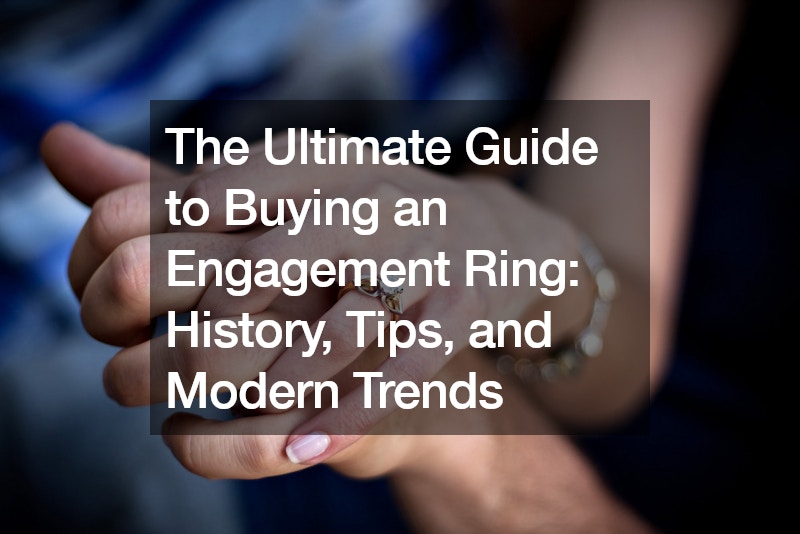
Buying an engagement ring is a monumental step in any relationship, symbolizing love and commitment. It’s a purchase filled with emotion, tradition, and personal significance. Here’s everything you need to know about choosing the perfect ring, from its historical origins to modern buying tips.
A Brief History of Engagement Rings
The tradition of giving engagement rings traces back to the 15th century when Archduke Maximilian of Austria popped the question to Mary of Burgundy with a rare diamond ring. This event sparked a trend among European nobility, who began to see diamond rings as a symbol of love and commitment.
Initially, engagement rings featured various precious stones, not just diamonds.
In the late 19th century, the discovery of diamonds in South Africa led to the rise of DeBeers, a cartel that played a crucial role in popularizing diamond engagement rings. Their marketing campaigns were so effective that they ingrained the idea that a diamond engagement ring is essential for a serious proposal. They also introduced the concept that a diamond should cost at least two months’ salary, a notion that has influenced buyers for decades.
Controversies and Alternatives
Diamonds, while beautiful, come with their share of controversies. Issues such as blood diamonds, environmental impact, and human rights violations are significant concerns. The Kimberley Process was introduced to certify diamonds that do not fund wars, but it does not address all ethical issues.
Lab-created diamonds offer an ethical alternative. These diamonds are chemically identical to mined diamonds but are produced in a controlled environment. They tend to be purer, more affordable, and eliminate the ethical issues associated with mining. However, it’s crucial to consider your partner’s preferences regarding sustainability and authenticity. Some may prefer the “real deal” of a mined diamond, while others might appreciate the sustainability of a lab-created gem. For those particularly concerned with the origin and impact of their purchase, ethical engagement rings are a perfect choice, ensuring that the love symbolized by the ring is free from ethical concerns.
Setting Your Budget
Forget the outdated two-month salary rule, which was a marketing strategy by De Beers. Your budget should reflect what you can afford without going into debt. The average engagement ring in the US costs around $4,000, but it’s essential to find a balance between cost and personal significance. Vintage rings can offer great value and unique designs, providing a lot more for your money.
Choosing the Right Ring
The first step in choosing the right ring is understanding what your partner likes. Have subtle conversations about their preferences for ring style, stone type, and metal. Do they prefer a traditional diamond or a colored gemstone? Are they drawn to vintage styles or modern designs? Answering these questions will guide your search.
When it comes to diamonds, understanding the 4Cs—cut, clarity, carat, and color—is crucial. These factors determine a diamond’s value and appearance. The cut affects how well the diamond reflects light, clarity refers to the presence of internal or external flaws, carat is the diamond’s weight, and color grades the diamond’s hue. Larger diamonds are disproportionately more expensive, so finding the right balance is key.
Where to Buy
You have two primary options for buying an engagement ring: online or in-store. Each has its pros and cons.
Online Shopping
Buying online can be convenient and often cheaper. However, it’s important to use trusted sources and ensure the option to return the stone if it doesn’t meet your expectations. Always get the stone independently appraised to verify its authenticity and quality. The advantage of shopping online is the no-pressure environment where you can take your time to make a decision.
In-Store Shopping
Shopping in-store allows you to see the diamond in person and benefit from a sales assistant’s expertise. However, you may face higher pressure to buy, and the selection might be smaller compared to online retailers. Building a relationship with a trusted jeweler, reading reviews, and ensuring a good return policy are essential steps. Additionally, in-store purchases can often be negotiated, providing some room for haggling.
Final Tips: Do’s and Don’ts
Do:
- Shop around and compare prices.
- Learn about common stone treatments to protect yourself from scams.
- Act with confidence to avoid being lowballed.
- Ensure the ring has a good return policy.
- Consider proposing with a temporary setting and choosing the final ring together.
- Look for vintage jewelry, as it can offer better value and craftsmanship.
Don’t:
- Buy on the first stop. Take your time to find the perfect ring.
- Choose preset stones, as settings can hide flaws.
- Fall for the “sparkle in the sunlight” trick, as even inferior quality stones can sparkle.
- Rely solely on certificates; have the stone independently appraised.
In Summary
Choosing an engagement ring is a significant and emotional purchase. By understanding the history, being aware of modern ethical concerns, setting a realistic budget, and knowing what your partner wants, you can find a ring that symbolizes your unique love story. Whether you opt for a traditional diamond, a lab-created stone, or a vintage piece, the right ring is out there waiting for you. Take your time, do your research, and you’ll make a choice that will bring joy for a lifetime.
.

